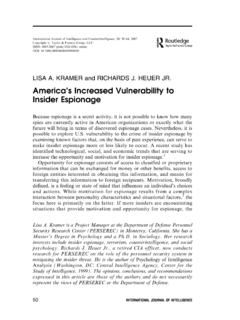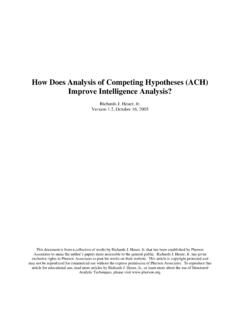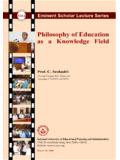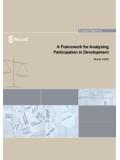Transcription of A Framework for Thinking about Collaboration …
1 MICROSOFT. A Framework for Thinking about Collaboration within the intelligence community Joan McIntyre Douglas Palmer Justin Franks kreynolds [Pick the date]. This article appeared in Collaboration in the National Security Arena: : Myths and Reality What Science and Experience Can Contribute to its Success in June 2009. The article is part of a collection that was published by the Topical Strategic Multilayer Assessment (SMA), Multi-Agency/Multi-Disciplinary White Papers in Support of Counter-Terrorism and Counter-WMD in the Office of Secretary of Defense/DDR&E/RTTO.
2 [Type the abstract of the document here. The abstract is typically a short summary of the contents of the document. Type the abstract of the document here. The abstract is typically a short summary of the contents of the document.]. Introduction The Director for National intelligence (DNI) envisions a globally networked and integrated intelligence enterprise created by integrating foreign, military, and domestic capabilities through policy, personnel and technology actions to provide decision advantage to policy makers, warfighters, homeland security officials and law enforcement The DNI.
3 Vision 2015 states that to meet the demands for greater forethought and strategic agility the intelligence community must evolve into a true intelligence enterprise established on a collaborative foundation of shared services, mission-centric operations, and integrated mission management, all enabled by the smooth flow of people, ideas, and activities across the boundaries of the intelligence community members. ii Underlying this vision is the goal to create a culture of Collaboration and an integrated intelligence enterprise. Over the last few decades, the term Collaboration as it has been used within the intelligence community , academia, and the organizational literature has been associated with a host of related terms such as teamwork, horizontal integration, communities of interest (or practice), jointness, netcentricity, and multi-INT fusion.
4 Each of these terms provides a somewhat different take on the concept of Collaboration . More recently, the emergence of new virtual Collaboration capabilities is broadening the depth and scope of collaborative activities. This paper seeks to provide a Framework for understanding the various concepts associated with Collaboration and to propose a common lexicon to enhance discussion about Collaboration . Defining the Terms Associated with Collaboration Webster's Dictionary defines Collaboration as working jointly with others, especially in an intellectual endeavor.
5 Most definitions of Collaboration embed and embellish on this concept of joint interaction. The MITRE Corporation, in a 1999 baseline study of Collaboration in the intelligence community defines Collaboration as the interaction among two or more individuals and can encompass a variety of behaviors, including communications, information sharing, coordination, cooperation, problem solving, and negotiation. iii The DDNI/A's Collaboration Consulting Team defines Collaboration as the interaction among members of the intelligence community and their partners exploiting their diverse expertise and organizational resources to create higher value intelligence than an agency or officer can do individually to achieve the mission of the intelligence community .
6 In all cases, Collaboration is defined as a behavior between individuals and is most closely associated with concepts as teams and teamwork. Multi-INT fusion, a distinctly intelligence concept, also entails such Collaboration but with the emphasis on bringing together diverse data sets into a common environment. Copyright 2009 Pherson Associates, LLC. All Rights Reserved. 1. Although often used interchangeably, Collaboration should not be confused with information sharing. As a colleague puts it, information sharing is when I give you a recipe for apple pie and you give me the name of a good mechanic.
7 The exchange does not necessarily lead to a higher value of output as a result. Information sharing or, more to the point, access to the same body of information is a necessary precondition for Collaboration to occur. In fields such as intelligence and other knowledge-based disciplines, the task of ensuring that the appropriate people have access to information should not fall on the shoulders of those attempting to collaborate. Those collaborating on a particular issue should share private knowledge and insights, but responsibility to ensure that the appropriate information is shared belongs to the organization.
8 In contrast to the definition of Collaboration , integration--defined as the act or process of incorporating into a larger unit--is a more abstract, impersonal concept describing structure within organizations or society. Vertical integration generally describes the Industrial Age command and control structure with communications and interactions flowing up and down a hierarchal organization. Horizontal integration emphasizes an organizational structure that fosters relationships and interactions that cuts across departmental and even organizational boundaries and is much more dependent on collaborative, non-authoritative behaviors.
9 As popularized in books such as Thomas Friedman's The World is Flat, the increased complexity of problems and the emergence of technologies have greatly expanded the speed of doing business and mechanisms individuals use to connect. This is driving organizations, including the intelligence community , to shift toward more horizontally integrated Netcentricity, to use the term coined by academia, focuses on the underlying networks that connect individuals and facilitate communications and trust. Networks are common features in biology (neural networks), infrastructure such as power grids, computer networks, transportation systems, and social networks.
10 Our understanding of networks is benefiting from comparative and multi-disciplinary assessments. The phenomena described in Malcolm Gladstone's book, The Tipping Point, are driven by interactions between networks of individualsv, and Duncan Watts' book, Six Degrees: The Science of a Connected Age, provide multiple examples and the theoretical underpinnings for concluding that the more interconnected a network is the more agile and capable of dealing with outside The recognition of the important role networks play has increased as organizations have shifted from vertically to horizontally integrated structures.








